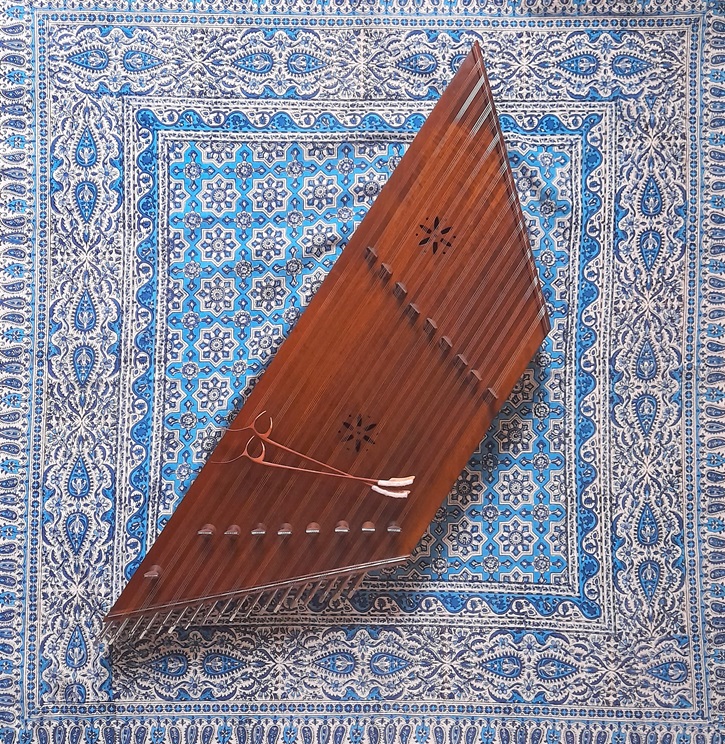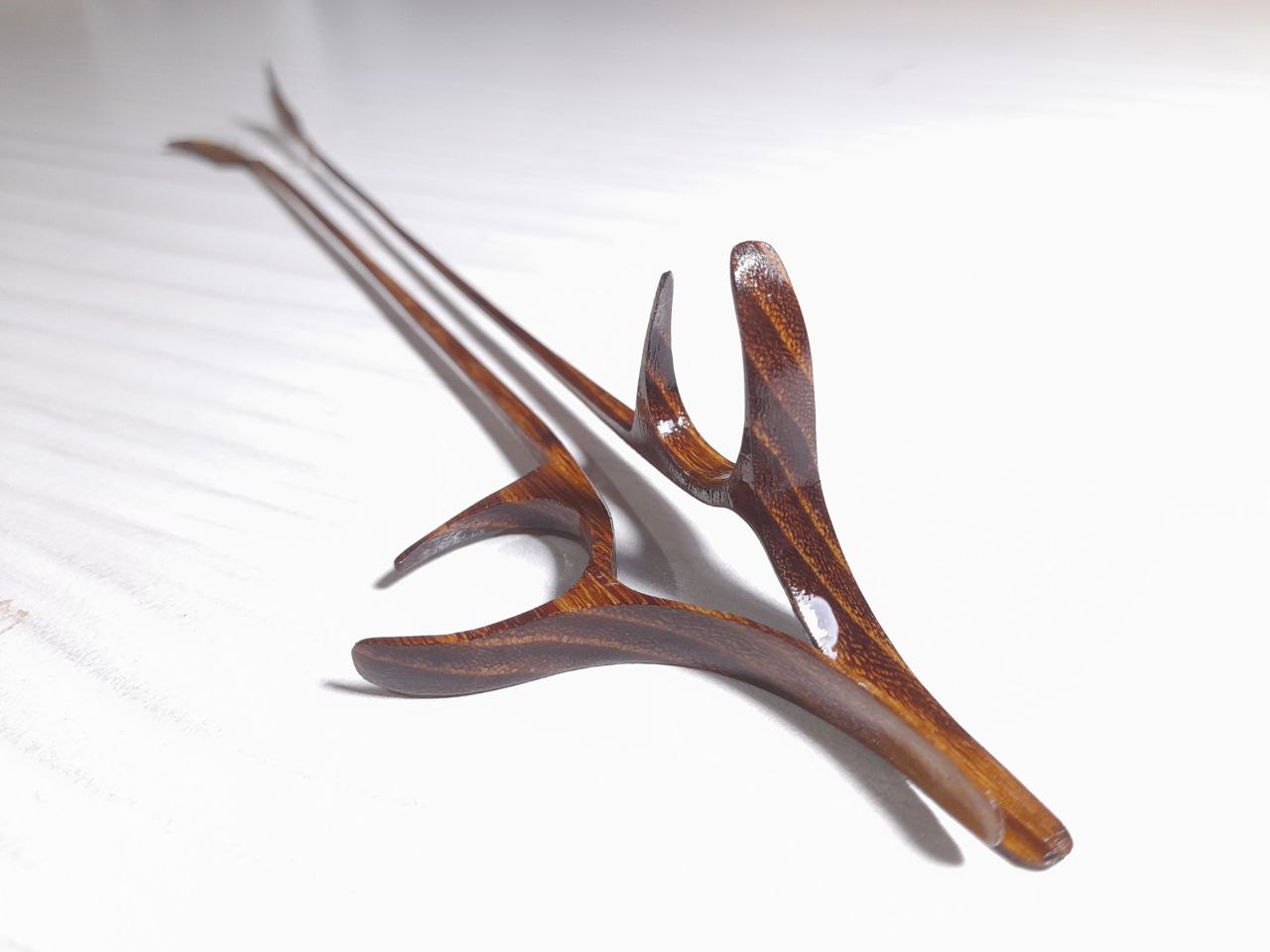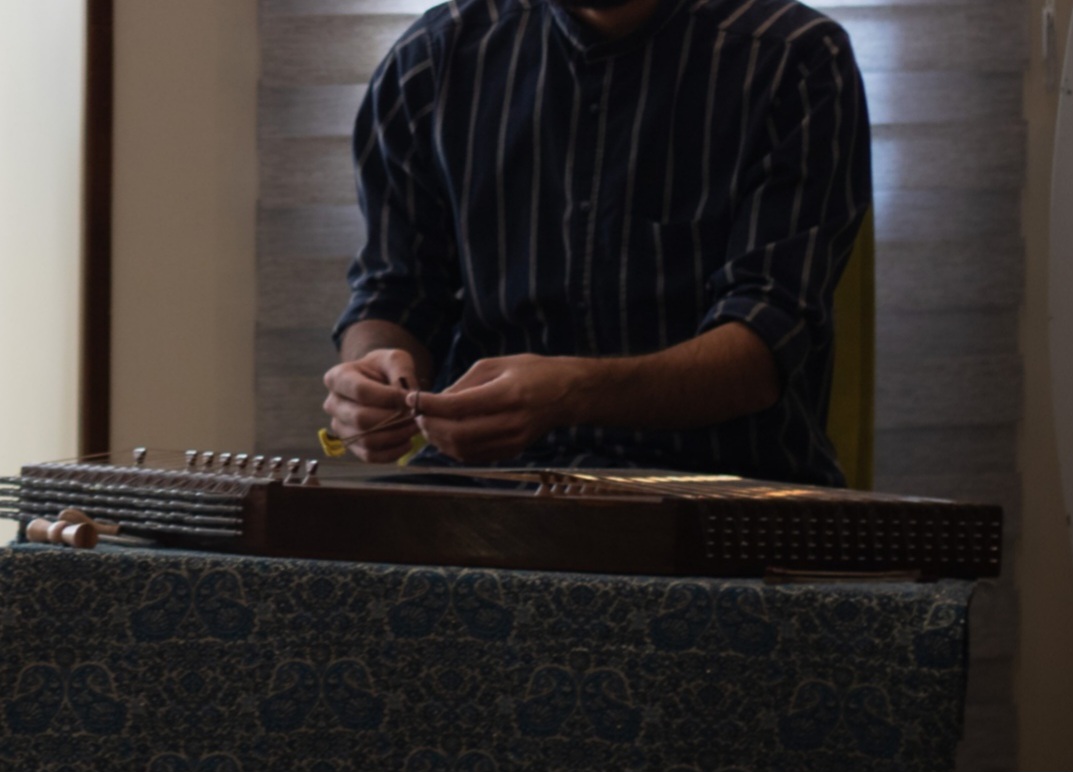
Erfan Hosseini, Santur Player
An Interview by MEHRSA MASTOORI
 mezrab
mezrabMM: I’m curious, when did your journey with santur begin? How old were you when you started learning to play this fascinating instrument?
EH: My musical journey began when I was about six years old, although my first instrument was not the santur, but the daf, which my older brother taught me how to play. As a child, I didn’t find it easy to handle the weight of the daf, but I persevered and eventually convinced my brother to let me play the daf in his band. I had the opportunity to perform numerous times.
We had a santur at home, but I never paid much attention to it until one day when I happened to open its case and examine it closely. I picked up the mezrabs and started playing, although I was not very skilled at it. However, because I was introduced to classical Persian music and familiar with some rhythms, I managed to avoid making unpleasant noises. My mother noticed my interest and asked if I wanted to learn how to play the santur. I was overjoyed and eagerly accepted the offer and so began to study the art of the playing the santur.
MM: What made you fall in love with this instrument? What specific features ignited your passion for learning it?
EH: During my childhood, the santur intrigued me with its unique synchronization of two mezrabs and the intricate hand movements required when playing it. Unlike other traditional Persian instruments, when one plays the santur, both hands are equally involved. This fact further intensified my fascination. The quick pace of santur playing also drew me to the instrument, and the challenge made me eager to practice and enhance my skills. While it isn’t the most crucial aspect of playing the santur, speed held a great deal of significance to me as a young musician, and I strived to achieve proficiency in this respect. As I matured, I realized that diligent practice was the key to mastering any instrument. Once I achieved some mastery, my passion for the santur was reignited. I fell in love with the instrument all over again.
MM: What kind of feedback have you received in response to your playing, and how did it shape your growth and development as a musician?
EH: Receiving feedback has always been a crucial part of my growth and development as a musician. I remember how, as a child, I struggled when challenged to learn complex classical pieces that were beyond my beginner abilities. Despite relentless practice, I felt overwhelmed and so I began to dislike playing the instrument — and music altogether. However, with the unwavering encouragement and some positive feedback from my family, friends, and those for whom I performed, my confidence in my playing and also my love for the instrument grew.
Over the years, I have learned to embrace criticism as a tool for improvement. While positive feedback is always appreciated, accepting and learning from negative feedback and constructive criticism has proven to be invaluable to my personal and professional growth. It allows me to identify my weaknesses and work towards enhancing my skills.
MM: What are your thoughts on the future of musicians in Iran, both in the country as it is now or as it might be if there were fewer cultural restrictions?
EH: In Iran, musicians often face challenges when seeking employment. Their salaries are low and, for the most part, they must earn an income through teaching rather than performing. As a result, music students must work hard to make a living. The only viable option for a musician to support him or herself in Iran is to teach music.
Another significant challenge for musicians is choosing between playing a popular music and playing classical music, which requires more training and skill. This issue existed even before the Islamic Revolution, when people had a more comprehensive understanding of music and could recognize different dastgah in Iranian classical music simply by listening.
Today’s musicians must strike a delicate balance between influencing current and future generations with their music and increasing their own knowledge of the art form. In a free Iran, feelings of patriotism would likely be stronger and interest in Iranian music more widespread. If job conditions were improved and greater value placed on Iranian classical music, all musicians would surely benefit.
It seems to me that prior to the recent revolution in Iran — which, I will say, sparked hope in the hearts of its people — Iranians did not, for the most part, feel patriotic towards their country. But in the past decade or so, there has been a shift: patriotic feelings have increased and the desire to remain in the country and contribute to Iran’s development has inspired Iranians to explore various avenues. With renewed hope, Iranians can envision a future in which musicians can flourish and artists can serve their communities while advancing their country.
MM: That’s an inspiring vision! Finally, I would like to ask you: since you began your career as a santur player, have you noticed an increase in the popularity of classical Persian music?
EH: Many people are currently drawn to learning about Iranian culture, due to the new sense of hope people now have. While Western music may have been more popular in the 1990s and 2000s, there has been a shift in recent years. For instance, there had been a discussion about mixing traditional santur techniques with Western approaches to music. What I’ve noticed is that more people are showing an interest in Iranian culture, especially traditional Iranian music. Many people are keen to listen to or even learn how to play such music. It’s been a long time since I’ve had students whose families encouraged them to study Iranian classical music. This trend is also evident in the field of art, where people are increasingly interested in Iranian architecture. I believe that recent events in Iran have played a role in fostering the growth of this interest.
A Santur Setting of the Poem “Dard-e Eshgh” by Erfan Hosseini
The words of the poem I sing in this excerpt are taken from “Dard-e Eshgh” by Salman Savoji — in English, “The Pain of Love.” In the world of Persian poetry, sacrifice is viewed as the highest level of love and compassion. Such love can be felt for a mother, a child, a country, God, or a partner — yar, as we say in Persian. The poet writes of a melancholic and painful love, but asks that he be allowed to bear the weight of his pain alone. He begs his yar to sit with him because when she is gone, his nights and mornings are intolerable. This painful feeling of love comes, however, with a present warmth and indescribable joy. The poet explains that he looks forward to years of experiencing this sweet, painful love in his heart and soul. The origin of this ballad is unknown. This is an arrangement I composed for the santur. This ballad creates contradictory feelings in me, as it is supposed to do. I played and sang this ballad to my wife the night I met her. Hearing it and playing it now brings back that night and evokes the strong and deep love I have had for her ever since.


